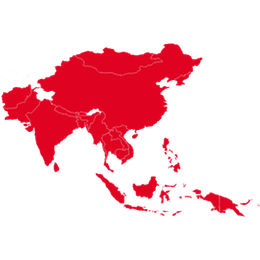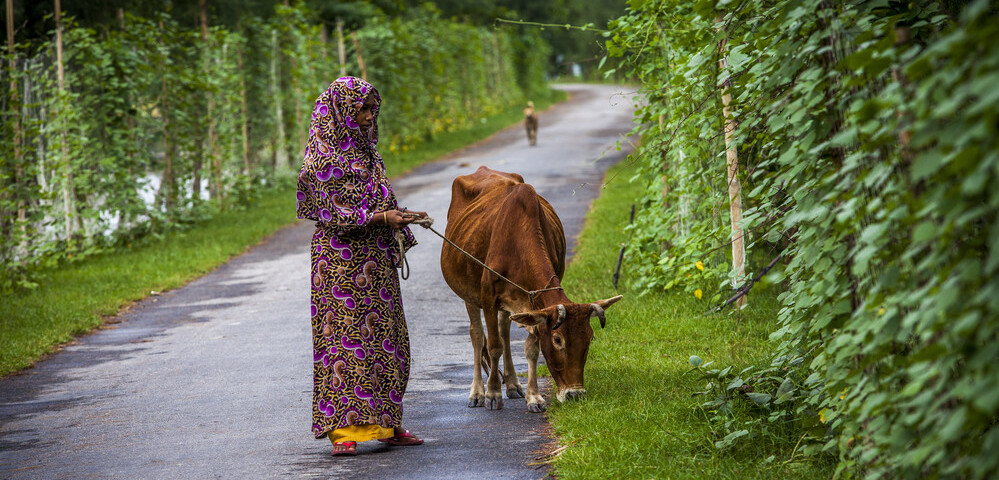Climate Adaptive Fodder Production
"Every farmer of the project reported that the growth of their animals was better than before, due largely to the higher levels of nutrition."
BACKGROUND
Satkhira is a district in the Southern region of Bangladesh, closely located to the Bay of Bengal which faces a major salinity problem. Sea water influxes heavily to the agricultural lands during the rainy season (May-August), and additional water logging is making land scarce for fodder production. To improve availability of essential fodder for livestock, the ‘Hydroponic Fodder Production’ technology implemented under IFAD PACE project is having tremendous result in terms of livestock production and sustainability.
WHAT’S INVOLVED
Hydroponic fodder technology
A method of growing plants in a water-based, nutrient-rich solution.
Training
The project provided extensive training on the technology as well as hands on solution during any difficulties faced.
Demonstration plot
The project arranged some demonstration plots to expand the technology among other dairy farmers
EXPLORE THIS SOLUTION
Climate adaptive fodder production can offer:
- Alternative for fodder production with reduced access to land
- Improved livestock productivity and adaptation to the changing climate

Countries involved
Bangladesh
Project partners
Department of Livestovk Services (DLS) of Bangladesh, Unnayon Prochesta
Project dates
2017-2019
Share this solution
Bookmark this solution
BookmarkShow Full Solution
Summary
Increased land salinity and waterlogging from the sea greatly affect countries like Bangladesh. In the coastal Satkhira district in the Khulna region, as in other similarly situated locations, meat and milk production have been negatively affected by severe reduction in the availability of natural fodder and grass.
To solve the scarcity of fodder due to these twin challenges of climate change, an IFAD-funded project explored fodder production through hydroponics. This technology has been shown to be suitable for the livestock production in the coastal areas of Bangladesh. Although the production costs are higher compared to traditional grass production, this technology provides uninterrupted fodder supply for the animals, with a positive effect on productivity.
Challenge/Problem
The International Panel on Climate Change (IPCC) identifies Bangladesh as one of the countries experiencing severe vulnerability from challenges related to climate change, noting that the adverse effect of climate patterns will continue to worsen Bangladesh's socio-economic conditions (IPCC, 2007). Especially in the coastal areas of the country, climate change is taking a significant toll on the viability of the livestock sector, decreasing naturally-grown fodder, a crucial factor in livestock production.
With its location along the coastline of Bangladesh, Satkhira district is particularly vulnerable to climate change. Many areas of the Khulna region, in which this district is situated, are being rapidly submerged. In addition, the remaining land is seriously salinized. These two situations have, over the years, resulted in a significant drop in the production of fodder and green grass in the region. Farmers are therefore largely dependent on concentrated, expensive feed that has less nutritional value, reducing productivity.
Solution
An IFAD-funded project, “Promoting Agricultural Commercialization & Enterprises (PACE) Project” of Palli Karma-Sahayak Foundation (PKSF), an apex development organization of Bangladesh addressed the issue by means of a technology transfer sub-project to explore the feasibility of fodder production using hydroponics technology. Through this technology, the level and quality of natural fodder production can be maintained, farmers can cope with the difficult climatic conditions, increase production to meet the challenge of food insecurity, and contribute to food security, agriculture and the national economy.
In the livestock sector, hydroponics technologies and practices within the local context are aligned with agro ecological principles to make the biological, socio-cultural, and economic systems more resilient. Hydroponics is a method of growing plants in a water-based, nutrient-rich solution. Hydroponics does not require soil; instead, farmers produce fodder in plastic trays. Water is sprayed on the plants twice or thrice daily. As a result, plant cultivation through hydroponics is 30-50% faster in growth than soil planting. In Bangladesh, hydroponic fodder is grown from cereal grains like maize, barley, wheat or sorghum.
The ‘Hydroponic fodder technology transfer project’ was implemented in Tala Upazila in the Satkhira district by a Partner Organization (PO) of PKSF named 'Unnayon Prochesta.' A large and ancient dairy cluster is located in the village of Ziala in Tala Upazila. 50 farmers in that cluster were selected to pilot activities to adopt the technology, receiving inputs and equipment from the project.
Since hydroponic fodder cultivation is a completely new technology in the project area, cash assistance was provided by PKSF to the members to set up demonstration production units under the `Hydroponic fodder technology transfer project’ of the IFAD-funded “Promoting Agricultural Commercialization & Enterprises (PACE) Project”. The project also provided training and technical support for the capacity development of the producers. To encourage other farmers to produce hydroponic fodder, several Farmer’s Field Days (FFD) were organized and leaflets containing information related to hydroponic fodder cultivation were also distributed to farmers in the catchment area.
Results
Milk production of dairy cattle has increased by up to 8-13% . Hydroponics are able to produce fodder within a short time (six to eight days) that is highly nutritious.
As a work-around to the challenge of land unavailability in Bangladesh, the solution enables the production of high yields of fodder in a small land area. For example, 600kg of maize fodder can be produced within 8-10 days in in an area of 50 square meters; compared with the same amount in 1ha of land under the conventional system with a longer production period of 45-60 days. To produce 1kg of fodder for 6 days about 1.5 liters to 3 liters of water is required. In contrast, producing 1kg of traditional fodder will require about 30 liters of water. Hydroponic fodder cultivation requires less labor, no soil preparation, no weed management etc. On top of that, there is no post-harvest loss in this process of grass production.
Every farmer of the project reported that the growth of their animals was better than before, due largely to the higher levels of nutrition.
Some farmers also reported an increase in milk produced by their cattle after they were fed on this fodder.
Lessons Learned/Potential for replication
- Financial viability is a major concern in the adoption of new technology like hydroponic cultivation in a community.
- Production quantity depends on the availability of good quality seed. Often a whole lot of grass is ruined due to a poor seed germination rate.
- Wide adaptation of this type of technology transfer requires a long time.
- This technology is not suitable for replication all over the country. It is mainly suitable for areas where the traditional grass cultivation opportunities are limited (i,e saline-prone, draught and waterlogged areas). Especially during natural disasters, this technology can be a good practice for maintaining livestock production.
Next Steps
A detailed cost-benefit and qualitative analysis should be done for further promotion of this technology. This is recommended to conduct a formal study to assess the cost and benefit of this technology as an informal estimated cost-benefit analysis was previously conducted. Market linkage initiatives should be built to ensure the availability of good quality seeds. Initiatives to expand this hydroponic fodder cultivation technology should be primarily in locations where the traditional grass cultivation opportunities are limited due to salinity, drought, and waterlogging (i,e. Shatkhira, Naogaon, Bhabodaho of Jashore). A pilot of this technology may also be implemented in other areas of high horticulture production, such as those for high-value leafy vegetables and flowers, especially orchids.
Solution Document Downloads
Solution Additional Resources
Socioeconomic Analysis of Hydroponic Fodder Production in Selected Areas of Bangladesh: Prospects and ChallengesLast update: 30/09/2022



